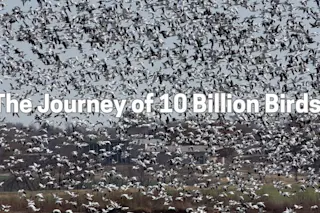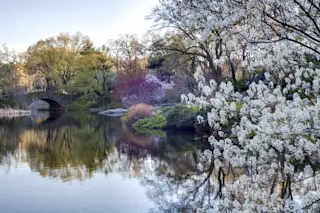There is a battle underway for the soul of environmentalism. It is a battle between traditionalists and modernists. Who prevails is likely to be determined by whose vision for the future is chosen by a new generation of environmentalists. The green traditionalist has never had a sunny outlook. Forty years ago, he warned about a plundered planet. Twenty years ago, he warned of a sixth extinction. In recent years, he has warned about a baked planet. Now he is warning of a planet under severe ecological pressure. Make no mistake: These are all warnings that deserve to be taken seriously. The green traditionalist, since he first became a career pessimist, has followed the lead of scientists. Just because the eco-collapse narrative remains the same doesn't mean it won't eventually come true. The problem for the green traditionalist is that this redundant message has lost its power. There have been too many red alerts, accompanied by too many vague, screechy calls to action. Today, the green traditionalist is like a parent who incessantly yells at his child to behave--or else. The parent grows angrier and increasingly frustrated when the child inevitably tunes him out. If there is a path to a more realistic, hopeful future, the green traditionalist has not advanced it. Getting back to the land was great hippy fun in the 1960s and 1970s. Inveighing against modern civilization and retreating into an artificial wilderness congealed in the 1980s and 1990s. Since then, green chic has been riddled with contradictions and ascetic deprivation has still been found wanting. Despite his broken-record messaging and inexorable slide into irrelevancy, the green traditionalist remains stubbornly resistant to new approaches. Like the ineffective parent, he keeps yelling, thinking his kids will eventually listen. As any parent will tell you, that's never worked. Enter the post-environmental, green modernist. Pro-technology, pro-city, pro-growth, the green modernist has emerged in recent years to advance an alternative vision for the future. His mission is to remake environmentalism: Strip it of outdated mythologies and dogmas, make it less apocalyptic and more optimistic, broaden its constituency. In this vision, the Anthropocene is not something to rail against, but to embrace. It is about welcoming that world, not dreading it. It is about creating a future that environmentalists will help shape for the better. As the geographer Erle Ellis recently wrote:
Creating that future will mean going beyond fears of transgressing limits and nostalgic hopes of returning to some pastoral or pristine era. Most of all, we must not see the Anthropocene as a crisis, but as the beginning of a new geological epoch ripe with human directed opportunity.
The green modernist recognizes that technology, as it has done all through human history, is a means to improve the human condition and reduce the worrisome ecological pressure on the planet. At the very least, as Mark Lynas writes in his new book:
We cannot afford to foreclose powerful technological options like nuclear, synthetic biology, and GE [genetic engineering] because of Luddite prejudice and ideological inertia.
The green modernist recognizes that conservation philosophy in the Anthropocene will have to change. But first it must stop worshiping at the wilderness cathedral and offer a world where nature and society can coexist harmoniously and productively. It must, as the Nature Conservancy's chief scientist Peter Kareiva (and co-authors) write in this essay, promise
a new vision of a planet in which nature -- forests, wetlands, diverse species, and other ancient ecosystems -- exists amid a wide variety of modern, human landscapes. For this to happen, conservationists will have to jettison their idealized notions of nature, parks, and wilderness -- ideas that have never been supported by good conservation science -- and forge a more optimistic, human-friendly vision.
This means recognizing that cities, long the bane of green traditionalists, are places where humanity and nature can thrive together. The evidence for this is, in fact, piling up. Of course, this is not to suggest that protected ecological reserves are unnecessary. As I said here, the existence of urban nature does not obviate the need for big tracts of unbroken habitat for animals to roam. "But," I wrote, "the idea that ecosystems and wildlife can still flourish in big cities challenges some of our cherished notions of nature." As Emma Marris observes in her new book, Rambunctious Garden:
Our mistake has been thinking that nature is something "out there," far away. We watch it on TV, we read about it in glossy magazines. We imagine a place, somewhere distant, wild and free, a place with no people and no roads and no fences and no power lines, untouched by humanity's great grubby hands, unchanging except for the season's turn. This dream of pristine wilderness haunts us. It blinds us.
Incidentally, if you're curious by what Marris means by "rambunctious garden," here is her explanation in a NYT Q & A:
When I came up with the title, it was meant to work on two levels. One level is that we have to accept at this point that the earth is maybe more like a garden than like a wilderness because we have done so much to it and we do so much changing and managing all the time that we we're in charge and we better just accept that. But if you just call it a garden, it implies that it's neat and orderly, like a little English knot garden. It doesn't have to be that way; it doesn't have to be soulless or too tidy. It can be wild and crazy and have a lot of vitality and spirit of its own.
In her book, Marris chronicles examples of managed nature and claims it is is indicative of a "paradigm shift" underway in the environmental world. Perhaps, but as I noted here, green traditionalists don't appear to be very receptive to the arguments put forth by Kareiva, Lynas and their fellow modernists within the environmental movement. That leads me to a New York Academy of Sciences panel discussion I attended this week, "Nature and the City: What Good is Urban Conservation?" At the outset, the moderator Bill Ulfelder noted the Marris book, Stewart Brand's manifesto, as well as this recent collection of essays, and asked: "Is conservation facing a paradigm shift, or is this buzz?" The other speakers on the panel seemed dubious about any major shift, but to a person they did suggest that the relationship between people and nature could be positively redefined by a newfound appreciation for urban ecology. I'll return to some of the highlights from the panel in an upcoming post later this week. For now, I'll stay with the main idea of this post, which is that green traditionalists find themselves increasingly challenged by green modernists. In a recent essay, the Breakthrough Institute's Michael Shellenberger and Ted Nordhaus argued that environmentalists should learn from the history of human progress. But they also acknowledge
the reality and risks of the ecological crises humans have created. Global warming, deforestation, overfishing, and other human activities -- if they don't threaten our very existence -- certainly offer the possibility of misery for many hundreds of millions, if not billions, of humans and are rapidly transforming nonhuman nature at a pace not seen for many hundreds of millions of years.
But the answer, they assert, is not to turn away from what we do best:
The solution to the unintended consequences of modernity is, and has always been, more modernity -- just as the solution to the unintended consequences of our technologies has always been more technology. The Y2K computer bug was fixed by better computer programming, not by going back to typewriters. The ozone-hole crisis was averted not by an end to air conditioning but rather by more advanced, less environmentally harmful technologies.
They conclude that the modernist green must be a champion of technology and prosperity:
Would we like a planet with wild primates, old-growth forests, a living ocean, and modest rather than extreme temperature increases? Of course we would -- virtually everybody would. Only continued modernization and technological innovation can make such a world possible.
At the New York Academy of Sciences panel on urban conservation, one speaker, noting the explosive growth of cities this century, said "the world is in a desperate race for urban sustainability." The outcome of that race is certain to determined by the forces of modernization and technological innovation. The sooner more greens understand this, the sooner that race can be won.













